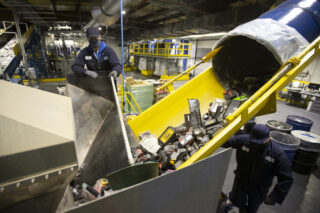Vroom…
We have entered the fast-growth phase for the electrification of transport. Worldwide, sales of cars with plugs jumped nearly 60 percent last year, and on that higher base, another jump of 30 to 35 percent is forecast for this year.1 By 2024, electric cars could be 20 percent of the entire global new-car market. These figures include fully electric vehicles, as well as plug-in hybrid vehicles, which can run for a fair distance on electricity before switching over to petrol. These hybrid cars have been an important transitional technology, but they are losing the race to fully electric cars, which now represent three-quarters of cars sold with plugs.2
Figure 17: Cars with plugs take off
Norway was early adopting favourable policies toward electric cars, and its entire new-car market has shifted. The rapid climb toward mass adoption is now occurring in many countries.
Source: IEA
The turnover of the car fleet is slow, and in most countries, those fast-rising sales mean that only a few percent of the fleet is electric as yet. We still have a long way to go to get fuel-burning cars off the highways. But we are certainly on our way: public interest in electric vehicles is intense and rising. In the major countries where car ownership is commonplace, we are at the point where the broad mass market is willing to consider making the switch. Buyers still confront serious problems that may deter them: too few charging stations, difficulty charging in apartment buildings or urban neighbourhoods, and more. The cars themselves are still far from perfect — taking too long to charge, for example. The 2020s will need to be a decade of confronting and solving thorny problems in the transition to electric vehicles.
Norway led the world in adoption of electric cars, with laws long on the books that charged markedly lower taxes for electric cars compared to ones burning petrol or diesel. Virtually the entire new-car market has switched to electric in Norway. Much of Europe is chasing Norway, with sales of electric cars well into double-digits: nearly a quarter of the market in the United Kingdom and 30 percent or more in Germany, the Netherlands, Finland and Denmark.
Electric cars also represent 29 percent of the market in China, where overall car sales are now double those of the United States. More than half of the electric cars being sold worldwide are being sold in China,3 which also dominates the supply chains for production of battery materials and batteries.
In California, the most populous American state, automobiles with electrical plugs now represent 24 percent of new-car sales.4 Enough of the state’s car fleet is now electric that total demand for petrol has begun to fall. In fact, ignoring the pandemic disruption of 2020, California petrol demand is down 13 percent5 from its recent peak in 2017. A truism of American life is that where California goes, the rest of the United States eventually follows. Cars with plugs now constitute 8 percent of all sales in the United States as a whole,6 a number that is expected to rise sharply under that country’s new climate law.
The electrification trend extends beyond passenger cars to encompass buses and some lorries or trucks, as well as the two- and three-wheeled vehicles so common in the developing world. In fact, electrified motorbikes have taken over approximately half of that market worldwide. This is likely to change in the future, but at the moment, the electrification of two- and three-wheeled vehicles is displacing more oil demand than the electrification of cars.
Figure 19: Oil displacement from vehicle electrification
Despite the rapid growth of electrified transport, global oil demand has yet to go into a persistent decline. Again ignoring the pandemic year of 2020 and the recovery year of 2021, demand has hovered close to 100 million barrels per day since 2018. One reason is the slow turnover of the fleet, with cars these days lasting a decade or longer before being recycled. Bloomberg New Energy Finance calculates that without aggressive new policies in favour of car electrification, it could be 2040 before half the world’s car fleet has an electrical plug. This implies that we could be in for a long plateau in oil demand, with a sharp decline not beginning until late this decade, unless governments push even harder on electric cars and lorries than they are doing now.
Figure 20: Global oil consumption, 1965–2022
The ‘CIS’ category includes the former Soviet Union and its successor states.
Perhaps the biggest question about the electrification of transport is whether the fast-rising demand for these vehicles can be met. An electric vehicle requires far more metals, chiefly for the battery, than a petrol car. The most important of these is lithium, the lightweight metal at the centre of modern battery technology. Several studies calculate that at least an eight- to 10-fold expansion of lithium production will be necessary if global climate goals are to be achieved.7
Other problematic metals are required for the transition. Cobalt is a component of some types of batteries, and much of the world’s supply comes from a single country, the Democratic Republic of the Congo, where it is commonplace for children to be exploited in small-scale mining operations. Another big problem, over the long term, could be the supply of copper, which is required not just in electric cars but in wind turbines and other technologies of the energy transition. Many of the world’s best copper deposits have already been exploited, and the quality of available ores has been declining.
Future of mining?

The Democratic Republic of the Congo holds the world’s largest cobalt reserves, and the conditions under which the ore is mined there belie that metal’s image as one of the keys to a greener future. Children often work in the Congolese mines, as in this one in the Mwenga territory of South Kivu province. Image: Augustin Wamenya/Anadolu Agency via Getty Images
These concerns about the supply of critical minerals for the transition have become serious enough that they are now a talking point for climate deniers, who use the fear of shortages to argue that climate goals cannot be met without severe economic disruption. Though rooted in reality, this is a disingenuous argument: not only is it ill-motivated, but it ignores the basic economics of commodity supply and demand.
Most people understand that in times of shortage, prices rise in order to allocate supply: if lithium is scarce, you will have to pay more to get your hands on it. But rising prices have a more important economic function: they call forth additional supply. That has already happened in the case of lithium, for example, where past price spikes prompted companies in Australia to open new lithium mines, so that Australia is now supplying almost half the world market.8 If prices continue to signal a shortage, we would expect more new lithium mines to come into production, though it will certainly take time. Lithium is sufficiently abundant in the Earth’s crust that there is no theoretical barrier to meeting future demand. As the graphic below shows, the potential future demand for lithium is far smaller by volume than some of the metals we already mine at scale.
Figure 22: Metals we mined in 2022, in kilotonnes
Large increases in the production of critical minerals will be required for the energy transition. The chart element at bottom right shows a forecast by the International Energy Agency of lithium demand in 2050, for example. The rest of the graph shows current production levels of various metals, leading us to believe that future lithium demand can be met.
Source: USGS and the IEA
High prices and shortages also create a powerful incentive for substitution of one material for another, and so do concerns about social welfare. Estimates of future cobalt demand have come down sharply, for example, as companies concerned about the situation in the Congo have figured out how to reduce or eliminate the cobalt required for their car batteries.
We are cautiously optimistic about the future supply of critical minerals for one more reason: the price gyrations in these markets are calling forth not just new supply, but new technology to help us augment that supply. One way of producing lithium is to extract it from brines in huge evaporation ponds, a slow and dirty technique. But several companies are working on modernised methods that could recover the lithium more quickly, and recover more of it. Similarly with copper, a new technique appears to allow the metal to be recovered from mine tailings that were previously treated as waste. If they live up to their promise, these approaches could deliver meaningful increases in the supply of critical minerals.
Lithium mining in Chile

Some lithium mines use immense evaporation ponds to concentrate the metal, demanding excessive land and water. But new technologies may allow for more efficient extraction. Image: John Moore/Getty Images
We may well be in for some rocky years as companies struggle to meet the fast-rising demand for these metals. We are likely to see temporary blips in the long-term trend of declining costs for electric vehicles, and possibly other technologies too. But economic history suggests the supply problem can and will be solved. We hope, this time, it will be solved with due regard for the rights of the people from whose lands these minerals will have to be extracted, and with due consideration for the welfare of the workers.
We also think as the global fleet of electric vehicles grows, battery recycling needs to become a critical priority. As we have seen in other markets, it can be tricky to get the economics of recycling to work, and doing so may require specific public policies, like the disposal fees already imposed on conventional car batteries. Do we need a disposal fee on electric-car batteries, paid up front by the first buyer of the car, with that stream of cash going to support the operations of battery recyclers? The time to figure this out is now.
Reclaiming metals

A worker wearing a protective mask uses a tool to push a load of batteries onto a conveyor at the Li-Cycle lithium-ion battery recycling facility in Kingston, Ontario, Canada. Image: Christinne Muschi/Bloomberg via Getty Images.
While the electrification of the car fleet is proceeding apace, it is less clear how society can tackle emissions from other forms of transportation. Batteries are improving fast enough that heavy lorries may yield to electrification, though some experts believe running them on hydrogen may be the easier path forward. Battery-powered planes are under development, but are likely to be useful only for short trips. Cutting the emissions from longer plane journeys will almost certainly involve sustainable aviation fuel, essentially a form of jet fuel made by methods that limit emissions. Yet again, the difficulty is cost: sustainable jet fuel today is several times as expensive as conventional fuel. But airlines are beginning to commit to using limited amounts of it, in hopes of sparking an industrial scale-up that drives the cost down. Ammonia, which can be made from green hydrogen, may turn out to be the fuel of choice for global shipping. A.P. Moller-Maersk, the huge Danish shipping conglomerate, is already pursuing that approach.
On the ground, public policies designed to cut vehicle emissions have focused heavily on electrification of transport. But everyone needs to recognise that electric cars and buses are not a magic answer. If we simply substitute an excessive number of cars on the roads with an excessive number of electric cars, we will still have congested cities, extravagant waste of metals and plastics, and many other problems. Electric cars do not even eliminate all harmful emissions at the point of use: some of the most damaging particles in the air come from brake and tyre wear, and because electric cars are heavier than conventional cars, those problems could even get worse.
It is critical, therefore, that governments begin to broaden the suite of policies they are using to tackle transport emissions. Redoubled investments in public transit need to be a priority in every part of the world with the population density to support it. If we can move people out of cars entirely, that would be better than simply moving them from petrol to electric cars. In cities overwhelmed by traffic, the congestion can be managed with a technique called congestion charging, in use for decades in Singapore and adopted more recently in London and Stockholm. New York City, after years of political struggle, finally appears to be on the verge of adopting a congestion charge, with the money raised from it devoted to improvements in public transit. We hope that success in New York will prompt other American cities like Chicago, Seattle and Los Angeles to move congestion charging to the top of the political agenda, and we also hope to see the trend spread to cities around the world.
Figure 24: Emissions per passenger kilometre
This chart shows emissions typical of various modes of transport. The figures are broad averages, and real per-passenger emissions can vary considerably depending on location, on how many passengers a bus or train is carrying, and other factors.
Source: UK Government
Congestion charging is one important part of a much broader project that we call city repair. If you have travelled to the Netherlands and seen how many thousands of people commute to work on bicycles, you should be aware that it was not always that way. In the 1970s, Amsterdam was as overwhelmed by cars, traffic and asphalt as any city in the world. But the deaths of scores of children playing in the street who were run over by motorists set off a political movement that, over time, wrought immense change in the cityscape. The same thing is happening now in Paris, which has launched a sustained campaign to reclaim road space from the automobile and turn it over to bicyclists and pedestrians.
Fixing cities

Utrecht, in the Netherlands, has undertaken an extensive programme of city repair. These before-and-after photos show how a freeway was torn down to make way for urban amenities, including the restoration of a historic canal. Before Image: Meijnen, W. After Image: Bas van Setten.
Even in the land of endless low-density suburbs, the United States, this battle has finally been engaged. Cities and, recently, entire states are eliminating zoning laws that prohibit the construction of apartment buildings, so that cityscapes can grow denser over time, and therefore more conducive to urban living and to mass transit. Truly absurd laws requiring minimum levels of ‘free’ parking, which ate up unnecessary land and drove up the cost of homes, are being repealed. These policies are relatively new in America, but they are already starting to pay dividends. After overly restrictive zoning laws were repealed in Minneapolis, for instance, a wave of apartment construction has ensued, and inflation in the cost of housing has moderated.9
This project of city repair is mainly about the quality of life in cities, not so much about the climate crisis. But the policies needed to get people out of cars and onto their feet or their bikes are entirely consistent with the policies needed to cut emissions and reduce dependency on the automobile. It may be the ultimate example of the old injunction to think globally and act locally: to repair our cities, to knit the damaged urban fabric back together, is to repair the world.
- 1. The International Energy Agency forecasts a 35 percent increase for this year, but we are slightly more cautious. See Alsauskas, Oskaras et al. “Global EV outlook 2023: catching up with climate ambitions.” International Energy Agency, 2023. Back to inline
- 2. Alsauskas, Oskaras et al. “Global EV outlook 2023: catching up with climate ambitions.” International Energy Agency, 2023. Back to inline
- 3. Alsauskas, Oskaras et al. “Global EV outlook 2023: catching up with climate ambitions.” International Energy Agency, 2023. Back to inline
- 4. “California Energy Commission Zero Emission Vehicle and Infrastructure Statistics.” California Energy Commission, last modified 20 August 2023. Back to inline
- 5. “Fuel Taxes Statistics & Reports.” California Department of Tax and Fee Administration, accessed 4 September 2023. Back to inline
- 6. Alsauskas, Oskaras et al. “Global EV outlook 2023: catching up with climate ambitions.” International Energy Agency, 2023. Back to inline
- 7. Researchers at the International Energy Forum and the Colorado School of Mines compared multiple studies forecasting demand for critical minerals. For lithium, the studies found a very wide range of potential demand by 2050, from 500 kilotonnes to more than 2,000. The median in those studies was 1,049 kilotonnes in 2050, leading us to say that ‘at least’ an eight-fold increase in production will be needed over the 130 kilotonnes produced in 2022. In Figure 22 of this report, we purposefully made a different choice, selecting a higher forecast of lithium demand from the International Energy Agency. This is a way of showing that even at the high end of forecasts, the future demand for lithium is likely manageable compared to production levels previously achieved for other metals. For the full range of demand forecasts, see Akamboe, Juliet et al. “Critical Minerals Outlooks Comparison: A Report by the International Energy Forum and the Payne Institute of Public Policy at the Colorado School of Mines,” August 2023. Back to inline
- 8. Venditti, Bruno and Sam Parker. “Visualizing the world’s largest lithium producers.” Visual Capitalist, 12 June 2023. Back to inline
- 9. Niquette, Mark and Augusta Saraiva. “First American city to tame inflation owes its success to affordable housing.” Bloomberg, 9 August 2023. Back to inline
